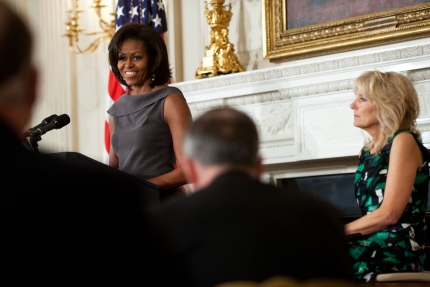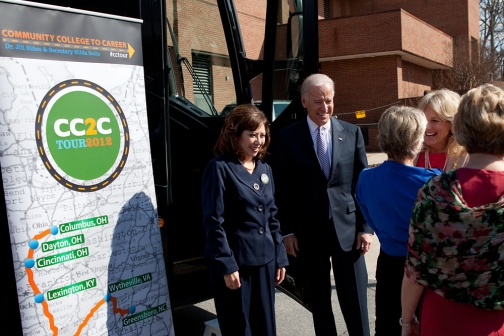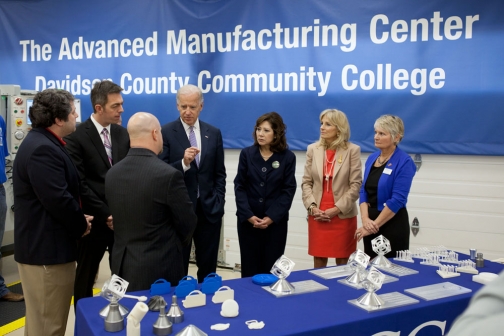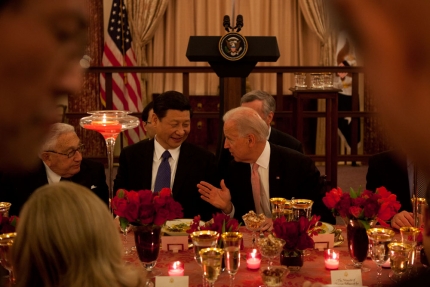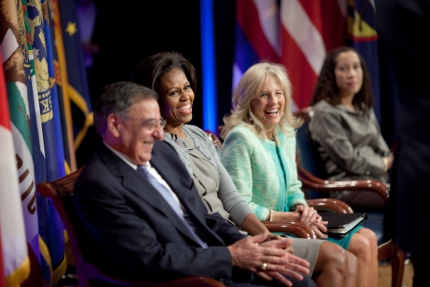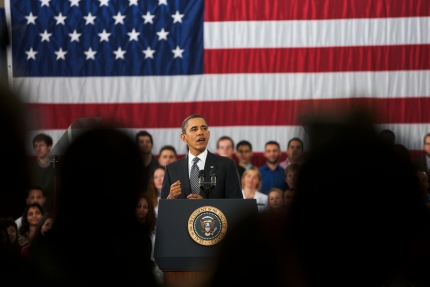Jobs News
Training Workers with the Skills Employers Need
Posted by on February 27, 2012 at 2:35 PM EDTLast Friday, Vice President Biden joined Dr. Jill Biden and Secretary of Labor Hilda Solis at Davidson County Community College in Thomasville, North Carolina to discuss the importance of training workers with the skills employers need right now. This visit was the final leg of a five-state, three-day Community College to Career Bus Tour that Dr. Biden and Secretary Solis took to highlight the $8 billion Community College to Career Fund recently proposed as part of the President’s FY 2013 Budget.
Speaking to over 300 faculty, students, and other members of the Davidson community, the Vice President argued that America’s skilled workforce is one of our greatest economic assets. But now that many American manufacturers and other businesses are growing again, too many are having trouble finding workers with the exact skills they need. That’s why it’s so important to forge partnerships between community colleges and businesses to train workers with the skills that employers need for jobs that are open right now. On Friday, the Vice President announced that the Administration is taking further steps to do exactly that by making available another $500 million to create and expand these partnerships as part of the Trade Adjustment Assistance (TAA) Community College and Career Training grant program.
The Administration’s efforts to create and expand these training partnerships are already showing results at places like Davidson County Community College (DCCC). Thanks to a grant they received in the first round of this program, DCCC has been able to expand their partnerships with local companies to train workers with the skills they need—companies like Ingersoll Rand, which is working with DCCC to train workers with computer numerically controlled manufacturing skills, or Unilin Flooring, which is training workers in electronics engineering. And these programs are working—in fact, every single graduate of the electronics engineering program at Davidson County Community College has been able to secure a job, many of them at companies like Unilin.
First Lady and Dr. Biden Urge Action from State Governors on Military Spouse Hiring
Posted by on February 27, 2012 at 12:31 PM EDTEarlier this morning, the First Lady and Dr. Jill Biden addressed the National Governors Association (NGA) Winter Meeting, the annual meeting that brings state leaders to Washington, D.C. to discuss important issues impacting all Americans.
Today, the First Lady and Dr Biden had one message for the governors: urging them to take action on the state level to support America’s military spouses.
In their travels to military bases across America and throughout the world over the last three years, the First Lady and Dr. Biden have heard stories from countless military family members and spouses. One of the top issues they hear about everywhere they go deals with the professional licensing requirements that affect how military spouses can move forward in their careers.
Less than two weeks ago, the First Lady and Dr. Biden joined the Secretary of Defense, the Chairman of the Joint Chiefs of Staff and all of the Joint Chiefs in rolling out a new report on state licensing.
This is an enormous issue for military spouses throughout this country. There are more than 100,000 military spouses who serve in the dozens of professions that require a state license or credential – teachers, nurses, childcare providers, dental hygienists, real estate brokers, speech pathologists and many other professionals. Each move to a new state can mean different credentialing or licensing standards – a process that can sometimes take months to resolve.
As part of their address to military families and Pentagon leadership, the First Lady and Dr. Biden announced an ambitious goal: for 50 states to pass legislation that supports military spouse license portability by 2014.
Eliminating Barriers to Growing our Economy
Posted by on February 24, 2012 at 7:35 PM EDTThroughout today and the rest of the weekend, President Obama will be meeting with governors from around the country. Today, he met with Democratic governors and talked about ways the federal government and the states can work together to create jobs and grow the economy. In particular, the President talked about ways to accelerate the growing trend of ‘insourcing’ – where companies are bringing jobs back to the United States and making additional investments here in America. The President’s conversation with governors about how we can work together to put Americans back to work and build an economy built to last will continue with a larger, bipartisan group of governors Monday.
Last year, around this time – along with similar meetings with governors – the President instructed agencies to work closely with State, local, and tribal governments to identify any Federal barriers that prevent efficient use of taxpayer dollars to achieve the best results.
Today we’re releasing a report highlighting examples of where these new partnerships are leading to real benefits for States, which include:
- More flexibility to design and implement education reforms. In exchange for agreeing to implement bold reforms around standards and accountability, the Administration is granting flexibility to states from the burdensome mandates of No Child Left Behind. The Administration recently granted waivers to the first 11 States that applied and looks forward to working with additional States.
- New job and workforce opportunities through the $37 million Jobs and Innovation Accelerator Challenge to promote economic development in high-growth industries, the $15 million Rural Jobs Accelerator to support jobs development, and $166 million to hire veterans under 2012 grants for Community Oriented Policing Services (COPS) Hiring and Staffing for Adequate Fire and Emergency (SAFER).
- Development of streamlined rules for Federal grants that focus resources on targeting high-risk areas to improve performance and target waste, fraud, and abuse.
- A forthcoming Executive Order to clear away the red tape that can slow down the construction of infrastructure projects.
Learn more about EconomyPresident Obama Highlights Smart Energy Training at University of Miami
Posted by on February 24, 2012 at 1:09 PM EDTEd note: this post originally appeared on energy.gov
During his visit to Florida yesterday, President Obama highlighted the University of Miami's Industrial Assessment Center (IAC) as a smart and important piece of the administration's "all-of-the-above" approach to domestic energy sources.
In September of last year, the Energy Department gave 24 universities a total of $30M in grants to help train the next generation of industrial energy-efficiency experts. Each school will receive $200,000 to $300,000 per year for up to 5 years to train students on core energy management concepts. The teams conduct energy assessments in a broad range of manufacturing facilities, which prepare students to compete in today's economy while helping local companies and factories reduce energy waste, save money, and become more competitive.
As President Obama said yesterday, "We're taking a step that will make it easier for companies to save money by investing in energy solutions that have been proven here at the University of Miami -- new lighting systems; advanced heating and cooling systems that can lower a company's energy bills and make them more competitive."
Since the Industrial Assessment Center program began in 1976, university teams have conducted more than 15,000 energy assessments at U.S. manufacturing plants nationwide. To date, more than 3,000 students have graduated from the Industrial Assessment Center program, with more than 60 percent going on to careers in the energy industry. Critically, these assessments have helped save over 530 trillion BTUs of energy -- enough to meet the energy needs of 5.5 million American homes -- and have helped participating manufacturers save more than $5.6 billion in energy costs.
Report from the Road: An Ambitious Plan to Train Ohio Workers for New Jobs
Posted by on February 22, 2012 at 7:48 PM EDTDr. Jill Biden and Labor Secretary Hilda Solis today kicked off a three-day “Community College to Career” bus tour to highlight the unique role community colleges play in developing a flexible, highly-skilled 21st-century workforce to meet emerging regional business needs. Secretary Solis is writing updates on the trip from the road.
Dr. Biden and I just visited DG Medical in Centerville, Ohio, to hear about the incredible BioOhio Workforce development partnership that is helping community colleges like Sinclair Community College prepare Ohioans for jobs in the growing biomedical manufacturing industry.
Sinclair is working with former GM/Delphi employees and other dislocated workers to get retraining to perform jobs making medical devices and life-saving drugs. They are part of a BioOhio partnership that has brought together industry leaders and six Ohio community colleges to match workforce needs with course offerings.
The ambitious goal is to graduate 700 Ohioans and place them in biosciences jobs as clean technicians, shipping clerks, packaging experts, manufacturing technicians and test engineers. More than half of existing program graduates already have found good-paying jobs in this field. Also, incumbent workers are being trained to move up the career ladder to become team leaders and front-line supervisors.
Watching this unique partnership at work illustrates why health care industry job growth continues to help drive our recovery forward.
Want to join the conversation by sharing how community colleges and industry partners are working together in your community? Share your story at http://obamawhitehouse.archives.gov/communitycollege/tour and follow and engage with the tour on Twitter with the hashtag #CCtour.
You can see more of Secretary Solis' posts at Work in Progress, the Department of Labor's official blog.
We Can’t Wait: Bringing New Investments to Rural Communities by Leveraging Existing Programs
Posted by on February 21, 2012 at 6:36 PM EDTSince the formation of the White House Rural Council in June 2011, we have had a unique opportunity to provide recommendations on how to grow the economy and create jobs in rural America.
The feedback we’re providing to the White House, based on our travels throughout the countryside, has helped us find creative ways to move the country forward without relying on Congress to act because rural Americans can’t wait.
Today's announcements are the result of the Rural Council’s ability to cut across large federal agencies to deliver results for rural families and businesses. Along with colleagues at the Departments of Commerce, Health and Human Services, and Labor, we announced three new ways to leverage existing programs and funding to drive economic growth in rural communities.
These announcements include:
- Promoting A Bioeconomy: President Obama issued a Presidential Memorandum today directing the federal government to dramatically increase the purchase of biobased products over the next two years, which will create jobs and drive innovation where biobased products are grown and manufactured. The biobased products sector marries the two most important economic engines for rural America: agriculture and manufacturing.
- Rural Jobs Accelerator: We are launching a national competition, providing about $15 million for projects that promote innovation-fueled regional job creation. The competition will combine funding from USDA, the Economic Development Administration, Delta Regional Authority and the Appalachian Regional Commission. USDA will utilize our Rural Community Development Initiative program to support this effort and provide technical assistance and training funds to qualified intermediary organizations to develop their capacity to undertake housing, community facilities, and community and economic development projects in rural areas.
- Rural Health IT Workforce: The Department of Health and Human Services and the Department of Labor signed a memorandum of understanding to connect community colleges and technical colleges that support rural communities with the materials and resources they need to support the training of Health Information Technology (HIT) professionals that work in rural hospitals and clinics.
Click here to learn more about the efforts of the White House Rural Council.
Kicking Off the Community College to Career Bus Tour
Posted by on February 21, 2012 at 5:39 PM EDTTomorrow, Dr. Jill Biden and Secretary of Labor Hilda Solis will embark on a three-day “Community College to Career” bus tour to highlight innovative industry initiativesthat are helping train students with the skills they need to meet area workforce needs.
President Obama recently announced an $8 billion Community College to Career Fund, co-administered by the Department of Labor and Department of Education,which will help forge new partnerships between community colleges and businesses to train two million workers with skills that will lead directly to jobs.
During the tour, Dr. Biden and Secretary Solis will visit several community colleges to learn about model industry partnerships, but we know there are many more success stories around the country (check out the full schedule below). We want to hear from community college faculty, students, business and community leaders about how these partnerships have benefited you and your community.
Check out this video from Secretary Solis asking for community college faculty, students and industry partners to share their stories. Got a story to share? Head over to WhiteHouse.gov/CommunityCollege/Tour to tell us about it or share your story on Twitter using the hashtag #CCtour.
Here’s the full schedule for the bus tour.
Enforcing Trade Agreements Protects Jobs
Posted by on February 21, 2012 at 12:10 PM EDTLast Friday, President Obama traveled to the Boeing aerospace factory in Everett, Washington. He met with workers and discussed his blueprint for an economy built to last with the renewed strength of American manufacturing. Part of the President’s message will focus on the Administration’s commitment to strong enforcement of U.S. trade agreements. The enforcement of trade agreements is vital to the success of large U.S. exporters like Boeing, as well as hundreds of firms of every size throughout Boeing’s global supply chain.
Here in the United States, from Washington to Kansas to South Carolina, tens of thousands of Americans depend on Boeing and its suppliers for a job and a place to put their skills to work. Trade agreements that guarantee a level playing field for global competition help make it possible for Boeing to sell its airplanes around the world in support of jobs here at home.
Boeing, like other American companies, knows from experience the importance of strong trade enforcement. For many years, the EU and its various member states provided Airbus, Boeing’s main global competitor, with more than $18 billion in subsidies. As a result, Boeing has been competing on an un-level playing field – losing market share and possible job-creating opportunities.
Fortunately, last year the Obama Administration secured a victory against EU subsidies to Airbus. It was the largest verdict in the history of the World Trade Organization. USTR is currently working to ensure that the EU implements the necessary changes and stops the illegal subsidies. Once implemented, this decision will lead to a more level playing field for Boeing and its many suppliers across America who support well-paying jobs for tens of thousands of hard-working Americans.
Learn more about , EconomyA Preview of the 2012 Economic Report of the President
Posted by on February 17, 2012 at 5:00 PM EDTThe Economic Report of the President has been prepared annually by the Council of Economic Advisers since 1947. The theme of this year’s Economic Report of the President is “To Recover, Rebalance, and Rebuild.” In 2011, the Nation continued to recover from the Great Recession and to make progress toward building a stronger foundation for more balanced and sustainable economic growth in the future.
The problems that caused the deep recession that began at the end of 2007 and lasted until mid-2009 were a long time in the making, and will not be solved overnight. But economic progress is being made. In 2011 the Nation continued to recover, rebalance and rebuild a stronger, more secure future. The economy has expanded for 10 straight quarters. As a result, by the third quarter of 2011, the real gross domestic product (GDP) of the United States had surpassed its peak level at the start of the 2007–09 recession.
When President Obama took office on January 20, 2009, the U.S. economy was contracting at an alarming rate, and employment was falling by more than 700,000 jobs a month. The plunge in economic activity was even deeper than the Bureau of Economic Analysis initially reported: revised estimates show that the economy contracted at an 8.9 percent annualized rate in the last quarter of 2008, from the initial advanced estimate of 3.8 percent. This was the largest quarterly downward revision ever reported.
Learn more about EconomyChart of the Day: Another Milestone in the Resurgence of the American Auto Industry
Posted by on February 16, 2012 at 3:30 PM EDTToday, we learned that each of the Big Three automakers posted a yearly profit for 2011. For the first time since 2004, all of those companies are operating in the black.
But those aren’t the only milestones we’ve seen recently in the resurgence of the American auto industry. Or in the comeback of the American manufacturing sector.
The January 2012 jobs report released earlier this month included another little-noticed milestone. The number of auto industry jobs added since GM and Chrysler emerged from bankruptcy after June 2009 now exceeds 200,000 — marking the strongest period of auto jobs growth since the late 1990s. That positive trend is particularly strong in the motor vehicle and parts manufacturing sector, which has added 121,900 jobs – a nearly 20 percent increase – since June 2009. And that growth is particularly notable given that some experts estimated that at least 1 million jobs could have been lost if GM and Chrysler had been liquidated.
Automotive Industry
(Motor Vehicles and Parts)June 2009 January 2012 Total Jobs Added Auto Industry Manufacturing 624,400 746,300 121,900 Auto Industry Retail 1,627,700 1,713,400 85,700 Total 2,252,100 2,459,700 207,600 Learn more about EconomyHelping Minority-Owned Small Businesses Start and Grow
Posted by on February 16, 2012 at 11:25 AM EDTAs we celebrate African American History Month, we are reminded of the remarkable men and women who have made an impact in our communities. For me, one of those individuals is my grandfather, an entrepreneur and business owner. My grandfather owned a landscaping company that became the first African American-owned firm in Indiana to win a state contract—for cutting the grass along state highways.
My grandfather’s business exemplified the positive role that small business owners play throughout the country. He made a point of supporting our community by hiring African Americans who had been cut out of the job market by segregation. Many of his employees prospered and some went on to start their own businesses.
I’ve seen firsthand the effect that small business ownership can have in all our communities, including communities of color. In fact, it is small business owners who are leading us down the path to economic recovery and prosperity once again. And, minority-owned small businesses are helping lead this effort.
Minority-owned businesses are some of the fastest growing segments of the economy. From 2002-2007, the number of small businesses owned by African Americans increased 60%. That’s more than triple the rate of businesses overall.SBA plays a key role in helping minority-owned businesses start and succeed. In the area of accessing capital, SBA is three to five times more likely to guarantee a loan to a minority- or woman-owned small business than a conventional lender.
When I joined the SBA team, I knew there was more I could do to help the underserved community. That’s why I helped to create the Council on Underserved Communities which advises SBA on ways we can further expand our reach into underserved communities. The council provides advice on everything from technical assistance, to access to capital, to outreach and education. We are honored to have Cathy Hughes, the founder of Radio One and TV One, and a former SBA borrower, serving as chair of the council. Here experience as a female, African American business owner has been a tremendous asset to the council and the SBA.
As President Obama mentioned during his State of the Union Address, our government is committed to ensuring that every aspiring entrepreneur gets a fair shot at small business ownership. It is a priority for us to support underserved communities and help small businesses in those areas create an economy built to last.
Vice President Biden’s Turn to Host Vice President Xi of China in the U.S.
Posted by on February 15, 2012 at 7:10 PM EDTYesterday, at the invitation of Vice President Biden, Vice President Xi Jinping of the People’s Republic of China spent the morning at the White House for a series of meetings with President Obama, Vice President Biden, and other Administration officials. Vice President Xi’s visit to the United States this week – which includes stops in Washington, D.C., Iowa and California – is the second of the planned reciprocal visits between the Vice Presidents announced by President Obama and Chinese President Hu Jintao during President Hu’s state visit to Washington last year.
Welcoming Vice President Xi to the Roosevelt Room in the West Wing of the White House, Vice President Biden reflected on his four-day visit to China last August. “As we discussed in my visit to China, this bilateral relationship is one of the most important in the world… important not only to both our countries but to the world at large,” he said.
From the White House, the Vice Presidents continued on to the State Department for a lunch in Vice President Xi’s honor, co-hosted by Secretary Clinton. Over 200 guests enjoyed Asian-inspired dishes prepared by acclaimed Chinese-American chef Ming Tsai.
“Few other nations in history have come so far, so fast, and it’s a great credit to the talent and industriousness of the Chinese people,” Vice President Biden said in his remarks.
Learn more about Economy, , Foreign PolicyFirst Lady and Dr. Biden Urge State Action to Support Military Spouses with State Licenses
Posted by on February 15, 2012 at 7:05 PM EDTEarlier today, I had the great privilege of joining the First Lady, Dr. Biden, members of Congress, the Secretary of Defense, the Chairman of the Joint Chiefs of Staff, the Joint Chiefs and state legislators at the Pentagon for a major announcement impacting our nation’s military spouses.
In their travels to military bases across America and throughout the world over the last three years, the First Lady and Dr. Biden have heard stories from countless military family members and spouses. One of the top issues they hear about everywhere they go deals with the professional licensing requirements that affect how military spouses can move forward in their careers.
These spouses are among the more than 100,000 military spouses who serve in one of 50 professions that require a state license or credential – teachers, nurses, childcare providers, dental hygienists, real estate brokers, speech pathologists and many other professionals.
Here’s why this matters: military families are asked to move again and again as their husband or wife serves our country. In fact, military spouses move at a rate that is 10 times greater than the civilian population.
Each move to a new state can mean different credentialing or licensing standards – a process that can sometimes take months to resolve. In so many cases, these are qualified professionals who simply can’t work in their field because they’re waiting on paperwork.
An America Built to Last: Strengthening Economic Security in Retirement
Posted by on February 15, 2012 at 6:42 PM EDTIn his State of the Union message last week, President Obama laid out a blueprint for an America that’s built to last—where hard work pays off and responsibility is rewarded. Today, the Departments of Treasury and Labor are taking steps to strengthen economic security for our nation’s seniors by giving Americans greater investment information and access to more choices to plan for a secure retirement. These steps will be of particular importance to women, who tend to live longer and have fewer retirement assets and lower retirement income than men.
The Department of Labor is taking action to require 401(k) plan providers to better disclose the cost and nature of the services they provide, while Treasury and the IRS are announcing steps that will ease regulatory barriers in the market for annuities and other forms of lifetime income. The Council of Economic Advisers (CEA) has prepared a detailed report describing the significance of today’s actions, which can be accessed here.
Today’s announcements complement previous Administration initiatives to make retirement more secure for American families. In September 2009, President Obama announced expanded opportunities for automatic enrollment in retirement savings plans. The President has also championed an automatic IRA legislative proposal through which tens of millions of workers without access to a workplace retirement plan would be automatically enrolled in IRAs through payroll deposit contributions, while remaining free to opt out. And the Administration has proposed easing requirements on the timing and amount of distributions from retirement accounts for many retirees, reducing the compliance burden and providing elderly Americans with greater control over their retirement assets.
Learn more about EconomyFirst Lady and Dr. Biden Urge State Action to Support Military Spouses with State Licenses
Posted by on February 15, 2012 at 5:29 PM EDTEarlier today, I had the great privilege of joining the First Lady, Dr. Biden, members of Congress, the Secretary of Defense, the Chairman of the Joint Chiefs of Staff, the Joint Chiefs and state legislators at the Pentagon for a major announcement impacting our nation’s military spouses.
In their travels to military bases across America and throughout the world over the last three years, the First Lady and Dr. Biden have heard stories from countless military family members and spouses. One of the top issues they hear about everywhere they go deals with the professional licensing requirements that affect how military spouses can move forward in their careers.
These spouses are among the more than 100,000 military spouses who serve in one of 50 professions that require a state license or credential – teachers, nurses, childcare providers, dental hygienists, real estate brokers, speech pathologists and many other professionals.
Here’s why this matters: military families are asked to move again and again as their husband or wife serves our country. In fact, military spouses move at a rate that is 10 times greater than the civilian population.
Each move to a new state can mean different credentialing or licensing standards – a process that can sometimes take months to resolve. In so many cases, these are qualified professionals who simply can’t work in their field because they’re waiting on paperwork.
Americans Tell President Obama What $40 Means
Posted by on February 14, 2012 at 9:11 PM EDTPresident Obama today asked Americans to share their stories, and tell him what losing $40 per paycheck would mean to their family. Thousands responded, sending us photos, tweets, and emails that illustrate just how important decisions made in Washington are to regular people across the country.
At the end of this month, a two-month extension of the payroll tax cut will expire. If Congress doesn't act, taxes will go up on 160 million hardworking Americans. For a family making about $50,000 a year, the payroll tax cut amounts to about $1,000 a year, or about $40 in every paycheck. It may not seem like a lot of money to some people, but for the people who wrote to us today, that money can make a big difference. Here are some of their stories:
 Please, consider that many people like my family live by paycheck only, we cannot even have extra money for emergencies, because living life in this country is so expensive that our paycheck goes to pay rent, bills, and food, and sometimes we don't even have for food. So, please DO NOT take that extra $40.00 taxes cut from our paycheck. -- Brenda from California
Please, consider that many people like my family live by paycheck only, we cannot even have extra money for emergencies, because living life in this country is so expensive that our paycheck goes to pay rent, bills, and food, and sometimes we don't even have for food. So, please DO NOT take that extra $40.00 taxes cut from our paycheck. -- Brenda from California To me and my family, $40 is the difference between opportunity and misfortune. When you include registration fees, uniforms, and expenses for equipment, travel and food, extracurricular activities alone can exceed $40 a paycheck (particularly if that money is divided over more than one child). Activities like baseball, martial arts, or community theater are far too important to children's health, development, and well-being to not be apart of their lives. But when it comes down to paying bills and for essentials or extracurricular activities, all one can say is "sorry kids, no baseball this year"! -- Eric from South Carolina
To me and my family, $40 is the difference between opportunity and misfortune. When you include registration fees, uniforms, and expenses for equipment, travel and food, extracurricular activities alone can exceed $40 a paycheck (particularly if that money is divided over more than one child). Activities like baseball, martial arts, or community theater are far too important to children's health, development, and well-being to not be apart of their lives. But when it comes down to paying bills and for essentials or extracurricular activities, all one can say is "sorry kids, no baseball this year"! -- Eric from South Carolina
With my paycheck being the sole source of income for our family, $40 means EVERYTHING to us. Having $40 means we can afford groceries in those last few days before my next paycheck so we won't go hungry. It means I can put a FEW gallons of gas in my car to make it to work for the next few days. It means I can afford a copay should my son need to see a doctor. It means we MAY be able to afford a prescription should we be prescribed one. We have done a short sale on our home, cut our budgets back to bare minimum, have relinquished all luxuries in our life but, yet still get up each day with the hope of something better. So, what does $40 mean to me? It means the difference between a healthy happy family that can sleep at night with a full stomach or having to tell my son that we may all have to go to bed hungry. -- Amanda from Virginia
 $40.00 means the world to my family and I. When the paycheck ends before the second week has begun, $40 is the difference between paying the mortgage or the light bill. We don't live beyond our means, our cars are paid for. We remodel our home, and maintain the cars ourselves and we work hard for what we have. For Thanksgiving we hosted over 40 friends and relatives. Not because we had that luxury, but because we invited everyone to bring a dish because we knew they couldn't afford the entire meal. We never thought we would get so many. Too many of our friends and family members have been devastated by the current economic downfall of this country. Many own/owned their own business and all are hard working decent Americans. Many, like myself, worked or were/are affiliated with both state and federal government agencies. We know all too well about politics and government spending. Some of our friends and associates are very wealthy and continue to be compensated far too well. $40 for us, that's $960 for the year or groceries for three months, five months of electric bills. When you're financially capable, $40 dollars is a night out at the movies, but for us and too many Americans, it is groceries for three months.
$40.00 means the world to my family and I. When the paycheck ends before the second week has begun, $40 is the difference between paying the mortgage or the light bill. We don't live beyond our means, our cars are paid for. We remodel our home, and maintain the cars ourselves and we work hard for what we have. For Thanksgiving we hosted over 40 friends and relatives. Not because we had that luxury, but because we invited everyone to bring a dish because we knew they couldn't afford the entire meal. We never thought we would get so many. Too many of our friends and family members have been devastated by the current economic downfall of this country. Many own/owned their own business and all are hard working decent Americans. Many, like myself, worked or were/are affiliated with both state and federal government agencies. We know all too well about politics and government spending. Some of our friends and associates are very wealthy and continue to be compensated far too well. $40 for us, that's $960 for the year or groceries for three months, five months of electric bills. When you're financially capable, $40 dollars is a night out at the movies, but for us and too many Americans, it is groceries for three months. Now with 10 grandchildren, our 6 kids still respectfully rely on our support from time to time. We remember when we could hand them $40 each to go to the movies with high school friends on a Saturday. Now, $40 assists them with groceries for the week. We continue to motivate them, and we try to keep everyone's spirits high with "it will get better if we just stick together until it gets better". -- Michael from Maryland
Read more stories:
Learn more about Economy2013 Energy Budget: What It Means for You
Posted by on February 14, 2012 at 3:12 PM EDTYesterday, Secretary Chu detailed President Barack Obama's fiscal year 2013 budget, which includes a $27.2 billion request for the Energy Department. The Secretary emphasized the President's commitment to an all-of-the-above energy strategy that includes critical investments in innovation, in job-creating clean energy technologies, and in our national security. You can check out a video of the event below.
"The United States is competing in a global race for the clean energy jobs of the future," said Secretary Chu. "The choice we face as a nation is simple: do we want the clean energy technologies of tomorrow to be invented in America by American innovators, made by American workers and sold around the world, or do we want to concede those jobs to our competitors? We can and must compete for those jobs. This budget request includes responsible investments in an American economy that is built to last."
Specifically the President's FY 2013 budget request for the Department of Energy:
- Invests in cross-cutting research to lead in the research, development, deployment and production of clean energy technologies;
- Promotes efforts to make solar power affordable for all Americans by reducing the cost of solar energy by 75 percent and making it cost competitive without subsidies by the end of the decade;
- Continues the Obama Administration’s efforts to reduce our dependence on oil by one-third by 2025;
- Supports groundbreaking basic science, research and innovation to solve our energy challenges and ensure that the United States remains at the forefront of science and technology;
- Strengthens national security by reducing nuclear dangers and maintaining a safe, secure and effective nuclear deterrent; and
- Advances responsible environmental management by cleaning up the legacy from the Manhattan Project and the Cold War.
Learn more about , Economy, Energy and Environment2013 Transportation Budget: What It Means for You
Posted by on February 14, 2012 at 11:24 AM EDTEd note: this post originally appeared on Fastlane, the official blog of the Department of Transportation
It has been more than two years and four months since America's transportation funding expired. Congress has extended the law with short-term patches eight different times. But, with bridges crumbling and highways choked with congestion, our nation needs the planning certainty that comes from a long-term transportation bill, a bill that puts people back to work rebuilding our roads, bridges, transit systems, and airports.
So this week, President Obama outlined a six-year surface transportation proposal–part of his blueprint for an America built to last. The transportation budget the President proposed has three broad goals:
- Creating jobs and investing in infrastructure for our future;
- Modernizing transportation through focused research and technology; and
- Pressing forward on our number one priority--safety.
An America built to last needs a strong transportation infrastructure. Without the ability to move goods and people safely and efficiently, we're stuck standing still. That’s why the President’s budget will improve America’s highways, rail lines, and transit networks, allowing for growth and continuing to ensure that these systems are safe.
Of the President’s proposal, $305 billion would fund road and bridge improvements. Now, that's a long overdue 34 percent increase over the previous transportation bill. And this proposal will also streamline and simplify our highway system by consolidating more than 55 different programs down to just five.
Learn more about , EconomyWhy Congress Must Extend the Payroll Tax Cut Through 2012
Posted by on February 14, 2012 at 7:00 AM EDTToday, President Obama has invited a group of Americans who made their voices heard the last time Congress threatened to raise their taxes to the White House.
At the end of this month, if Congress doesn’t act, taxes are set to go up on 160 million hardworking Americans, and the President believes that lawmakers must prevent this middle class tax hike without drama or delay.
For a family making about $50,000 a year, the payroll tax cut amounts to about $1,000 a year, or about $40 in every paycheck. In December, we asked America to tell us what losing $40 per paycheck would mean for their family, and the answers came from across the country — from students trying to stretch the budget a little bit further. From moms who need to buy their children lunch every day in the school cafeteria. And from commuters who are filling up the tank and looking at rising gas prices. Using twitter, email and Facebook, they told us clearly that $40 can make all the difference in the world.
Ultimately, thanks to these stories, Congress did the right thing and passed a two-month extension of the tax cut and unemployment insurance – but only after a drawn-out debate that put the strength of our economy and the security of middle class families at risk. Now that extension is about to expire.
The President is also inviting all Americans who oppose raising their taxes to share their own stories with the White House – you can submit them on WhiteHouse.gov, using the Twitter hashtag #40dollars or post them on our Google+ page or Facebook wall. You can watch the President’s remarks with these hardworking American families at 10:40 am ET on WhiteHouse.gov/live.
Learn more about EconomyPresident Obama's 2013 Budget is a Blueprint for an America Built to Last
Posted by on February 13, 2012 at 7:58 PM EDTPresident Obama traveled to Annadale in northern Virginia this morning to talk about his budget for the 2013 fiscal year -- and how it will boost job creation to speed our economic recovery.
A core set of themes helps to define this budget, and in talking to the crowd, the President laid out those ideas:
[An] economy built to last demands that we keep doing everything we can to help students learn the skills that businesses are looking for. It means we have to keep strengthening American manufacturing. It means we’ve got to keep investing in American energy. We've got to double down on the clean energy that’s creating jobs. But it also means we've got to renew the American values of fair play and shared responsibility.
To help reflect that shared responsibility, the President is proposing a new set of reforms that guarantees that millionaires don't pay a lower rate in taxes than the middle class. He said:
Right now, we’re scheduled to spend nearly $1 trillion more on what was intended to be a temporary tax cut for the wealthiest 2 percent of Americans. We’ve already spent about that much. Now we’re scheduled to spend another trillion. Keep in mind, a quarter of all millionaires pay lower tax rates than millions of middle-class households. You’ve heard me say it -- Warren Buffett pays a lower tax rate than his secretary. That’s not fair. It doesn’t make sense at a time when we've got to pull together to get the country moving.
If you want to read the complete budget, you can download the PDF, or get a copy for your Barnes & Noble Nook. We'll have a version for Amazon Kindle and Apple iBooks soon.
Learn more:
- For a complete overview of the budget, check out this post Acting Director of the Office of Management and Budget, Jeff Zients.
Learn more about , Economy
- &lsaquo previous
- …
- 2
- 3
- 4
- 5
- 6
- 7
- 8
- 9
- 10
- …
- next &rsaquo

